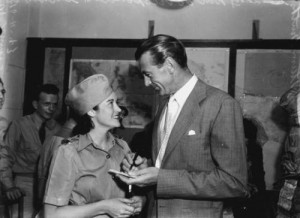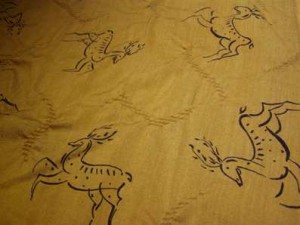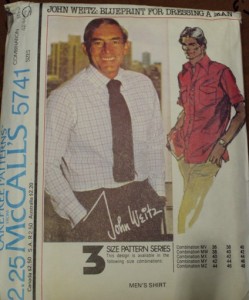 Once upon a time, I saw a PR photo of Gary Cooper (“Coop”) which struck me strongly in terms of how a) fashionable he was for the period and b) how soft the collar on his shirt looked in comparison to what we are used to today. Now, for the time, unless an actor was being photographed in movie costume as a ‘movie still’ shot for magazines, newspapers and advertising or for the movie posters, that actor was being photographed in street or evening clothing as part of the studio PR campaigns (as you recall, they were under contract to movie studios and were seen as assets to be used to promote the studio itself as well as promote themselves to build a fan base). As a matter of fact, many actors (Cooper included) were used in magazine editorial and in photo advertisements (I think Cooper did advertising not only for Knox Hats but also for a high end men’s shirt company as well). So, the ‘formality’ of the dress (which as I recall was a tweed sport coat, gingham shirt and knit tie, an outfit that would have been seen as ‘high end country house’ clothing at the time. He was probably also wearing wool flannel slacks and suede shoes as well) was really part and parcel of the shot.
Once upon a time, I saw a PR photo of Gary Cooper (“Coop”) which struck me strongly in terms of how a) fashionable he was for the period and b) how soft the collar on his shirt looked in comparison to what we are used to today. Now, for the time, unless an actor was being photographed in movie costume as a ‘movie still’ shot for magazines, newspapers and advertising or for the movie posters, that actor was being photographed in street or evening clothing as part of the studio PR campaigns (as you recall, they were under contract to movie studios and were seen as assets to be used to promote the studio itself as well as promote themselves to build a fan base). As a matter of fact, many actors (Cooper included) were used in magazine editorial and in photo advertisements (I think Cooper did advertising not only for Knox Hats but also for a high end men’s shirt company as well). So, the ‘formality’ of the dress (which as I recall was a tweed sport coat, gingham shirt and knit tie, an outfit that would have been seen as ‘high end country house’ clothing at the time. He was probably also wearing wool flannel slacks and suede shoes as well) was really part and parcel of the shot.
Cooper, for all of his being known at the time for his Western and frontier movie roles (which he got at the beginning of his career due largely to his riding and other outdoors skills from growing up on a ranch in Montana, though he and his brother were also sent later as teens to a boarding school in England for several years before he came home to attend college), certainly did not come from a poor or un-schooled family and for all the roles that required him to say “M’am” to actresses such as Dietrich, was very well read, was a trained artist and was, in his own way, as concerned about his appearance and the message it sent as Cary Grant was (though for different reasons). And he was seen at the time as a guy who dressed well and who cared about it (which at the time was no big deal; everyone dressed as well as they could afford to at the time; ‘clothes make the man’ was something everyone believed). The photo above was shot while he was touring in Australia entertaining US troops during WWII (which is why I can use it copyright free – it’s courtesy of State Library of Queensland) and he’s signing an autograph for a military fan.
If you look closely at the photo you will notice that the collar on his shirt is, to our eyes, quite long (the standard at the time was between 3″ and 4″ for collar points and men chose their collar length based on how tall they were). And though this photo does not show it, collars and cuffs at that time were quite soft (in relation to what had come before in terms of removable collars which were very stiff, either because they had been starched or made of celluloid). I asked my ‘men’s shirt and interfacing expert,” Pam Erny of Fashion Sewing Supply about this and she was quite clear on this. At the time, this was pre-fusible interfacings and shirt makers either used self-fabric (that is, they used the same sort of fabric that the shirt had been made of) or they used a similar weight of shrunk muslin or other fabric to back up the collar, cuffs and placket. At this time, it was pretty standard for men’s shirts to be starched as either part of the washing process or in the pressing process so having a fabric interfacing that would behave pretty much as the outside layers would in the washing the pressing was probably seen as the right way to go. This would change later with inventions such as ‘Sanforize'(tm) and other fabric labor-saving treatments; at that point, resin-based interfacings came into being basically to replace having to separately starch collars, cuffs and plackets.
But, as usual, I digress. Back to Mr. Cooper, a soft collared shirt and making a new shirt for the DH (who goodness knows has been patiently waiting for me to make HIM something for a change). A couple of years ago, I bought some wool challis on the internet. Now, the moment I saw this fabric, it reminded me strongly of the sorts of printed shirts that you can see in photos from the 1930s and 1940s for men. Men’s clothing in that period actually was far less conservative than it is today and men’s shirts were actually available in far more colors and fabrications than they are now. Additionally, since at that time central heating was not as widespread (nor were buildings and homes insulated very much at all), wool came in far more weights, weaves, knits and fabrications than we find today and people were used to wearing wool in pieces of clothing that we don’t often see today (for example, Viyella was a very famous and valued brand for both men’s and women’s shirts, blouses and dresses and this was a combination of wool and cotton).
But, back to the challis. Now, the background color is pretty much spot on, but I still can’t decide if those reindeer are black or navy blue. The fabric also has a puckered texturizing treatment in it which, when I had washed it in the hottest water my washer can produce, became even more pronounced. This would make a very jazzy shirt for the DH for sure, but I felt that to be fair to the fabric, a more 1940s period look would be in order. It would be a more casual shirt than he usually wears, though he’d be able to wear it with dark dress pants with or without a plain dark tie and either a tweed sportcoat (a la “Coop”) or a corderoy sportcoat or sweater. And yes, I have shown the fabric to the DH, who is quite intrigued and it will be interesting to see how the fabrication works out.
Now, the background color is pretty much spot on, but I still can’t decide if those reindeer are black or navy blue. The fabric also has a puckered texturizing treatment in it which, when I had washed it in the hottest water my washer can produce, became even more pronounced. This would make a very jazzy shirt for the DH for sure, but I felt that to be fair to the fabric, a more 1940s period look would be in order. It would be a more casual shirt than he usually wears, though he’d be able to wear it with dark dress pants with or without a plain dark tie and either a tweed sportcoat (a la “Coop”) or a corderoy sportcoat or sweater. And yes, I have shown the fabric to the DH, who is quite intrigued and it will be interesting to see how the fabrication works out.
The pattern is one from McCalls from 1977.  designed under license with John Weitz (who actually was a very interesting guy: John Weitz ), who did a fairly extensive run with McCalls in terms of their men’s pattern line.
designed under license with John Weitz (who actually was a very interesting guy: John Weitz ), who did a fairly extensive run with McCalls in terms of their men’s pattern line.
At this point, I will close here because I will be using Pam Erny’s recommendation for interfacing for this to give it the right look, a sew in product that I am getting from her but which has not arrived yet (I’m haunting the post box). Once I get that, we’ll be able to take this project forward.
Onward!!

Though the style will be of the period, men would not have had access to that print, which is merry and modern. So DH will have the best of both worlds, as well as a shirt that fits impeccably. Lucky guy!
In northern Michigan in the 1950s and 60s, Dad wore Viyella shirts and then a Pendleton shirt jacket on top of that, then turned the thermostat way down.
Duchesse – I remember my mother just drooling over Viyella and mumbling about trying to find Viyella fabric to make us dresses since they would be warmer than the usual.